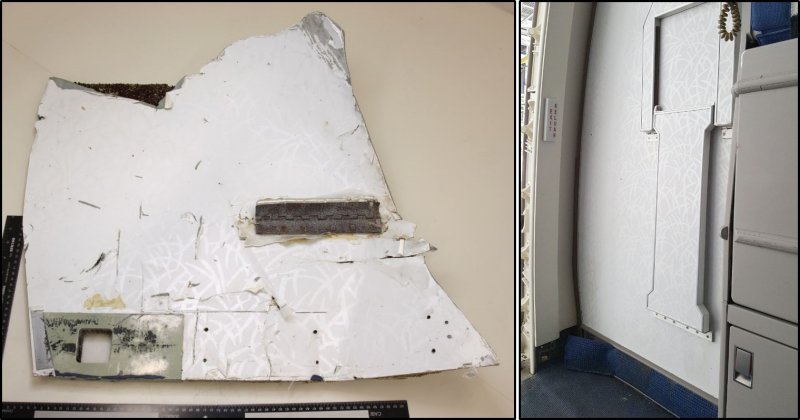
With two new pieces ‘almost certainly’ from the jet, we have the first indication that at least part of the cabin did not go to the bottom of the sea immediately.
For the first time there are indications that when Malaysia Airlines Flight 370 hit the water its fuselage was torn open by the impact.
Australian investigators have now identified a piece of wreckage found on a remote Indian Ocean island as “almost certainly” being part of closet door in the forward cabin of the Boeing 777 that went missing on March 8, 2014.
Four other pieces of wreckage so far recovered were from external parts of the jet: a wing control surface called a flaperon, found on Réunion Island; two pieces of a horizontal stabilizer, found near Mozambique; part of an engine cowling, found on the east coast of South Africa.
The Australian Transport Safety Bureau (ATSB) has announced that examination carried out by Geoscience Australia of the two latest pieces of debris to be discovered, the piece from a closet door and part of a Rolls Royce logo from an engine cowling, has matched them with parts specific to the Malaysian 777.
Until now experts have held open the possibility that the airplane’s cabin might have remained intact after impact while the other more vulnerable parts like the wings and the tail broke away—simulations made of the last minutes of the flight have the jet, out of fuel, gliding in a spiral toward the ocean, with possibly one wing hitting the water first. This left the possibility that the fuselage and central core of the wing would have swiftly sunk to the bottom of the ocean. In view of the discovery of the closet door that scenario now seems highly unlikely.
The survival of part of an engine cowling is less of a puzzle. The engines would shear away from the wings on impact and, because of their weight, sink rapidly. The external cowling with the Rolls Royce logo is, however, far lighter. This fragment floated the farthest distance, to the South African coast.
This kind of breakup would be consistent with what happened to the Airbus A330 in the crash of Air France Flight 447 into the South Atlantic in 2009. In that case pieces of cabin wreckage and 50 bodies were found floating once the crash site was located within days of the disaster. In the case of Flight 370 there was a complete absence of such precise knowledge of the crash location.
The story of the closet door shows the remarkably accidental nature of the way debris has been discovered and collected. It washed up on a beach on Rodrigues Island, east of Mauritius. As exclusively reported in The Daily Beast, the island lies atop a volcanic ridge and is encircled by a coral reef. There is a gap in the reef near the Mourouk Ebony Hotel, where a current apparently carried the debris to the beach where it was found by two holidaymakers.
The haphazard distribution of the debris discovered so far from Flight 370, stretching well over 1,000 miles west from Rodgrigues Island to the South African coast, suggests that there could be many more pieces that remained afloat for more than 500 days from the day of the 777’s disappearance. As the closet door shows, each piece has its own story to tell to investigators.
Curiously, though, the largest piece of debris, the flaperon, remains in the custody of judicial authorities in France while the rest is with the Australians.
Meanwhile, the $180 million undersea search for wreckage 1,700 miles off the coast of Australia has been temporarily suspended because of bad weather as the Southern Hemisphere winter sets in. Of the 46,000 square miles of the designated search area some 5,700 square miles, an area the size of Connecticut, remain to be searched.
And time is running out. The search is due to end within six weeks.
CULLED FROM THE DAILY BEAST






